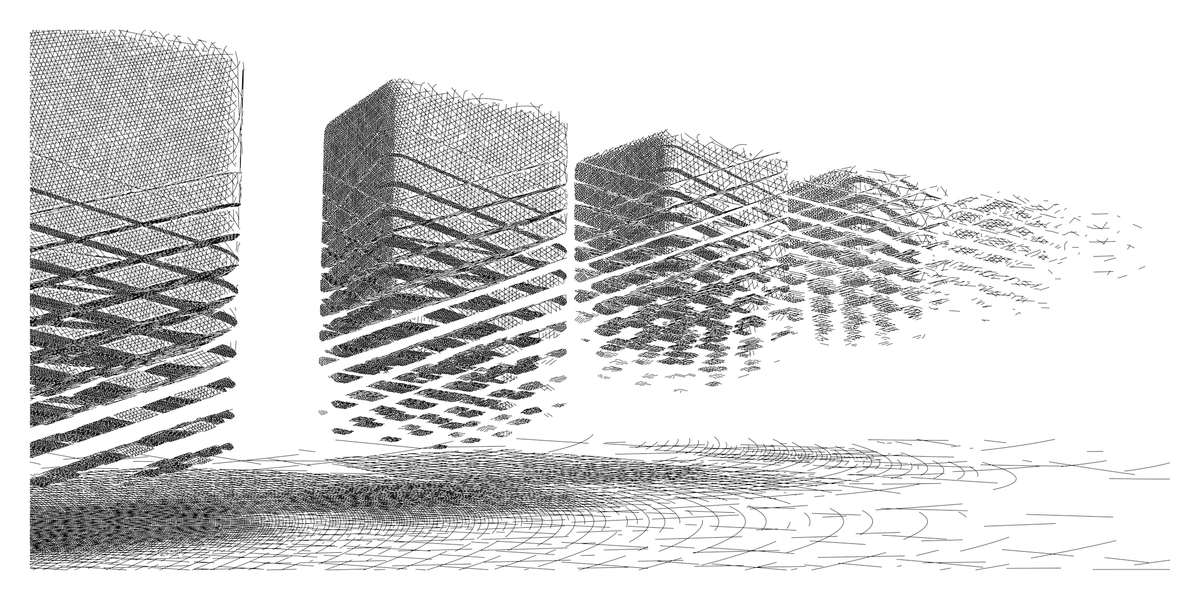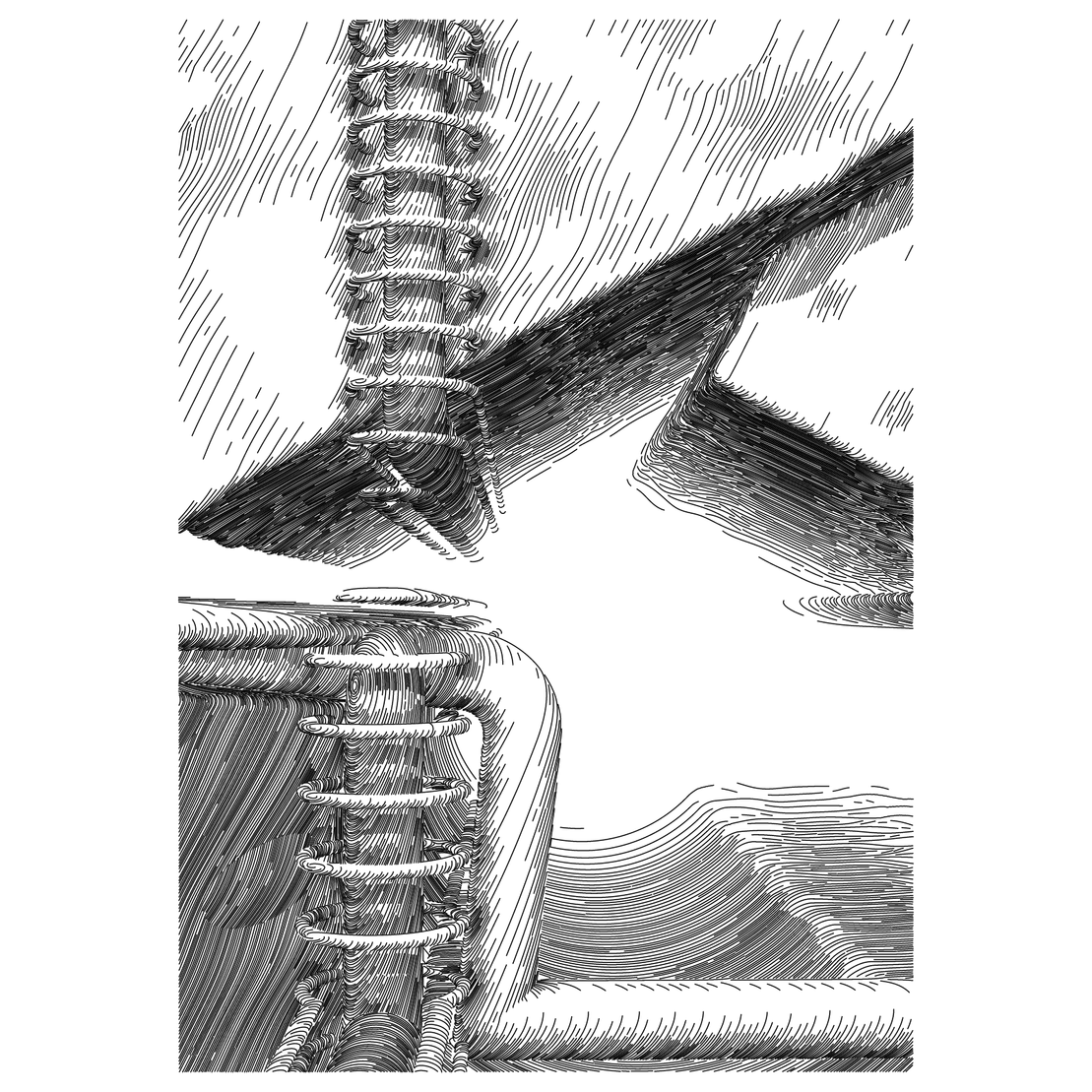
Rayhatching Evolution
written by Piter Pasma
RAYHATCHING chapter 1
In summer of 2020 I bought a plotter, a robot drawing machine that holds a pen. It is only capable of drawing lines, and nothing else.
Because of this I had been focusing on vector based SVG outputs. This is a file format particularly suited for the plotter, which builds images as a collection of lines and shapes, instead of pixels, like a JPEG does.
However, I felt the urge to play and experiment with 3D SDFs and raymarching again. An SDF is a mathematical function that describes shapes, in a way that is particularly suited to raymarching. Raymarching is a technique used for raytracing, which is a technique to simulate light bouncing off these 3D shapes, resulting in a picture. Unfortunately, these techniques are mostly aimed at pixel-based rendering, so I had to get clever.
In these first two pieces I use a raster-based scribbling approach to generate scribbles of varying size, creating varying levels of brightness.
In the next piece I use a very fine Hilbert curve, that gets progressively smoothed to create varying levels of brightness. This piece consists of a single line and could thus be plotted with relative ease (it still took a while).
Trying to find a way to render a raymarched scene with a shorter plotting time, I tried a different scribbling based approach.
While this reduced the plotting time somewhat, I was also not really satisfied with the lack of sharp detail in the picture.
I knew that 3D SDFs and raymarching were capable of much finer detail. Such as with my stippling-based pieces Possible Dune and Impossible Dune.
RAYHATCHING chapter 2
In order to figure out a way of achieving more detail with less lines, I tried taking surface orientation into account, which previous attempts had not done–they were just scribbling or stippling to create a certain brightness level. Notice how the very short lines in the next two pieces are oriented so that they seem to lie “flat” on the 3D surface. This was the first step towards a more intelligent hatching method.
These first attempts were merely made of very short lines, and were not really suitable for a plotter (or were they? I have footage of a powerful HP plotter going at it, taking only 50 minutes).
But I was getting there – I just needed to connect the dots, somehow.
Somehow it didn’t take too long to figure out how to use a flowfield renderer to draw the lines in a hatching direction on the shapes, while taking into account line distance to sketch different brightness levels. Capsule Hill was the very first successful output of the earliest version of the rayhatching algorithm.
From there on, it quickly got awesome.
However, I had also been organising the generative art month of Genuary 2021, in an attempt to bring together the various genart communities spread out over the web, and didn’t really have time to explore the rayhatcher further.
Genuary turned out to be a huge success, and quite the marathon, so I took a short break, then made a few more pieces.
And then NFTs happened :) And suddenly, digital art could just exist, without necessarily having a physical counterpart. Also at first, I had no idea how to combine NFTs with physical plots. So I explored the digital for a while, which led to Skulptuur and Hypergiraffe, amongst many other things.
I made Desirotron in this period, which is executed in colour, to underline it’s a digital image first, an NFT and not intended to be plotted (though if someone figures out how to make it look good they have my blessing).
RAYHATCHING chapter 3
It took until March 2022 until I revisited the rayhatching algorithm.
I completely rewrote the engine to be a completely self-contained file using no external dependencies (the earlier versions used modules I had written myself). I re-used the code for a very tiny QuadTree algorithm (an essential part of the flowfield renderer) from Hypergiraffe. At this point, the entire code was about 7 kilobytes, and after a few iterations led to Hyperwillows.
For a long time I had been saving parameters and important parts of the actual code as comments in the SVG-file (which is a text format, somewhat similar to HTML). This has proven very useful in recreating certain outputs on several occasions. The new rayhatcher engine is no exception, and it includes its entire code fully as an SVG comment in its output.
But Hyperwillows is a 1/1. I really wanted to do a big release of the rayhatcher algorithm as a long-form generative piece, that would be able to generate an infinity of possible outputs.
Some of my first tries I felt were too much like Skulptuur, looking at a peculiar object in the centre of the scene. So I did some reading and research on how compositions in paintings work. One approach I found is that of the “armature”, a set of imaginary lines that are important in the composition.
In particular, the armature known as the “rule of thirds”, which divides the image horizontally and verytically into thirds, seemed an easy one to start with. I developed an algorithm that could place SDFs of large blocks onto these lines, using a mathematical transformation from 2D (where the lines are on the image) to 3D (where the shapes are, in space).
When two shapes intersect, their surfaces form a cutting line. Due to the way that SDFs work, it is very easy to construct the SDF of a pipe following this line. I intersected the blocks with invisible planes to construct the pipes. Then I applied this method again, to the pipes themselves, intersecting with a stacked series of invisible planes. This creates the smaller “cooling rings” around the pipe. I also took a large hollow cylinder and punched a hole through the entire scene.
I quickly discovered that I could add a slight random rotation to the blocks to create more interest. This disturbs the “rule of thirds” armature a bit, but not too much and can also add other lines of interest.
After that, I added a noise texture to the blocks and some more tweaks and details. Relentless size optimizing turned this project into a piece of code weighing only 3930 characters.
project name project name project name
Industrial Devolution was released October 6th during a live minting event at Bright Moments gallery, Venice Beach, in collaboration with fx(hash) and Tender.
